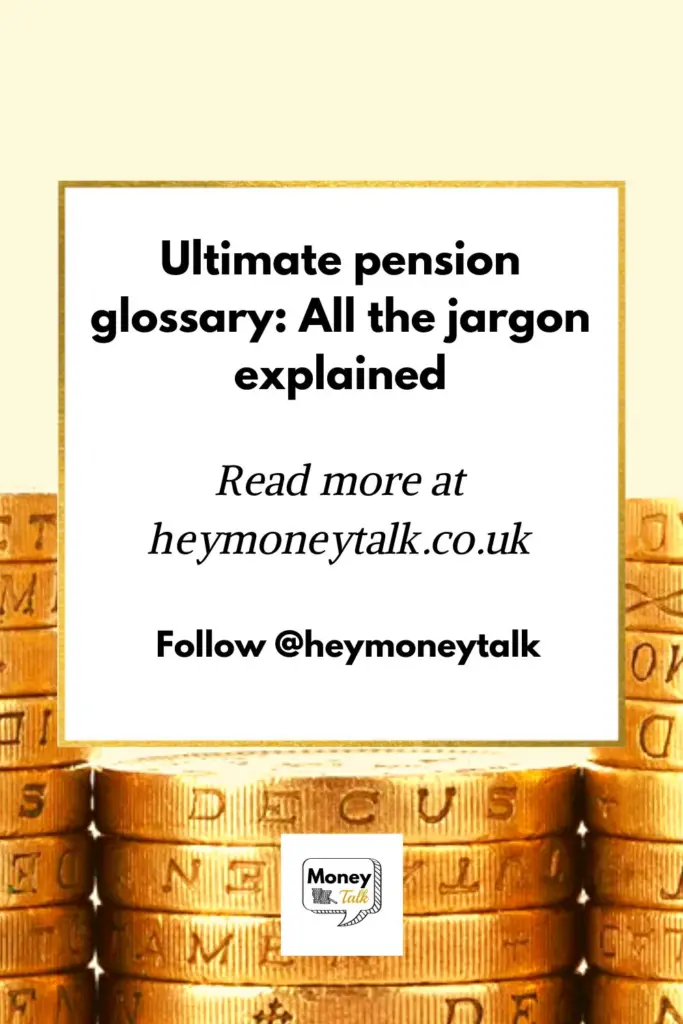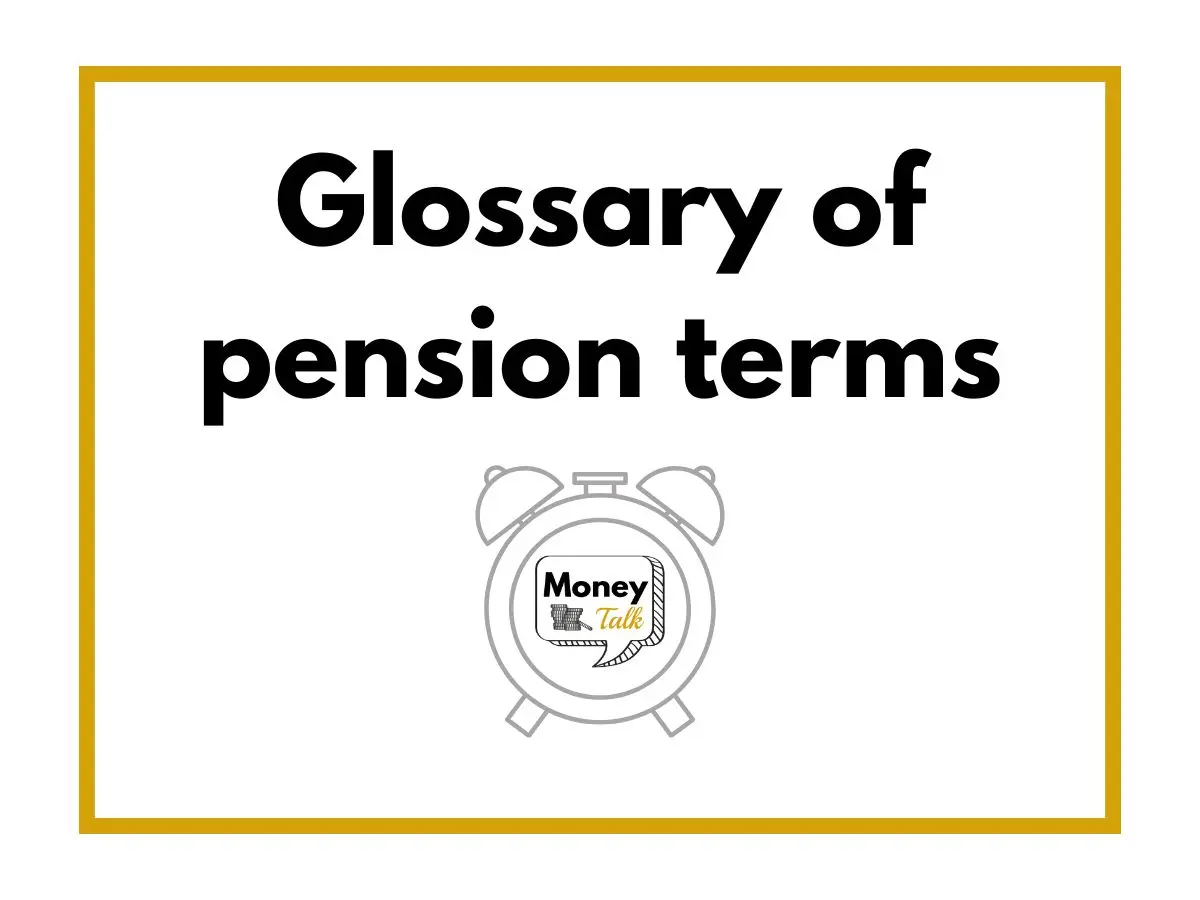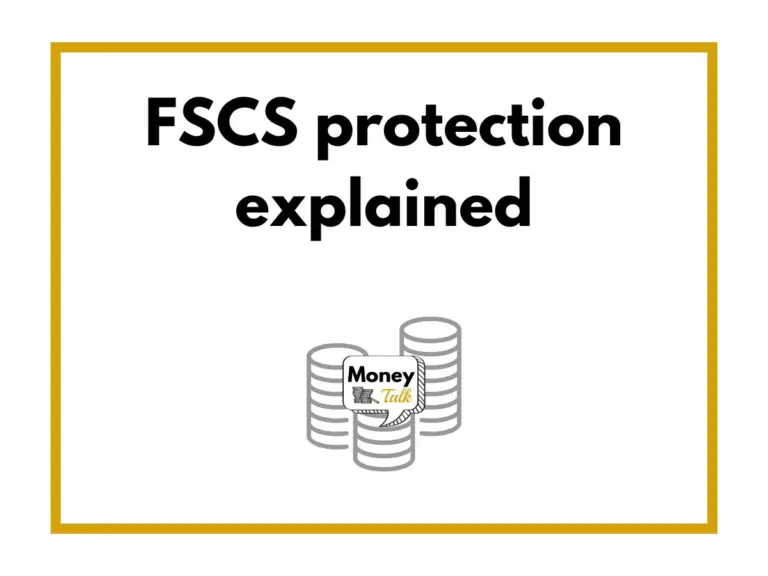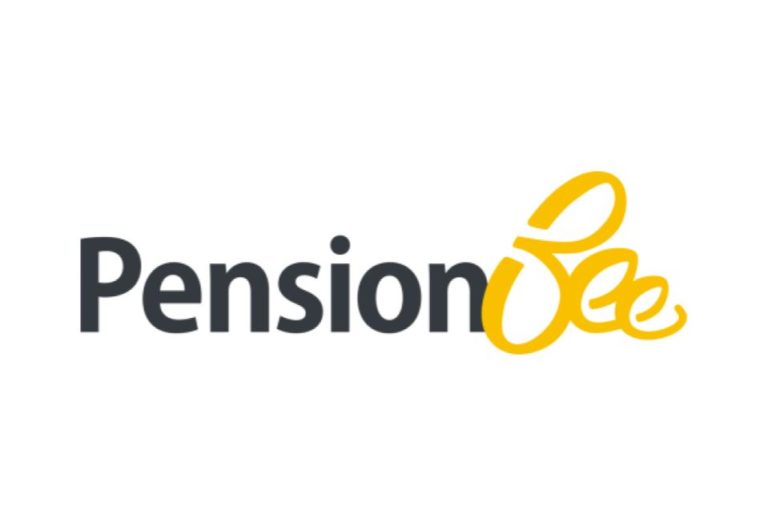Glossary of pension terms: All the jargon explained
Money Talk is intended to inform and educate; it's not financial advice. Affiliate links, including from Amazon, are used to help fund the site. If you make a purchase via a link marked with an *, Money Talk might receive a commission at no cost to you. Find out more here.
Pensions are one of the most confusing financial products out there.
When you’re thinking about retirement planning for the first time, it can feel like every second sentence contains a jargon that has no meaning when taken out of context.
Trying to sort out your pension is challenging enough – you shouldn’t need to decipher the documents you’re reading at the same time.
So to help, this glossary explains some of the most frequently used pension terms in a jargon-free way.
Additional voluntary contributions (AVCs)
If you’ve been automatically enrolled into your work’s pension scheme, you’ll be making regular contributions towards your retirement plan, with the money deducted from your salary.
However, you can also make additional contributions that are over and above what you normally pay.
This money is still deducted from your salary by your employer, and comes with all the usual tax incentives, but it sits in a separate pot.
It can also be a one-off payment or a regular one.
Crucially, the pot can be managed separately to your main pension.
Accrual rate
The accrual rate is the rate at which you build up your pension pot in a defined benefit pension scheme. It does not apply to defined contribution pensions.
The rate is typically given as a fraction; the bigger the fraction, the bigger the benefit.
To work out your annual pension income in a defined benefit scheme, you’ll need to multiply your final or average salary by the accrual rate and by the number of years you’ve worked.
For example, if your final salary is £50,000, your accrual rate is 1/60 and you’ve worked 20 years, you can expect an annual pension income of around £16,666.67.
Accumulation
Accumulation is the period when you’re still saving into your pension.
Active member
An active member is someone who’s still paying into their pension.
Annuity
When you’re ready to cash out your pension, one of the things you can do is buy an annuity with the money.
An annuity is basically an insurance product.
Depending on the policy you take out, it provides you with a guaranteed income for life or for a fixed period of time.
Annual allowance
The amount of money you can pay into a pension tax free each year is limited.
Currently, the annual allowance is £60,000 – assuming you haven’t already started making withdrawals from your pension.
If you’ve already started withdrawing from your pension then the money purchase annual allowance might apply instead.
Your allowance may also be restricted if you’re a high earner due to the tapered annual allowance rule.
Read this: How much can you pay into your pension each year?
Annual management charge
Pension providers will charge a fee for managing your pension.
This is generally given as a single figure – the annual management charge – but it might include the management fee as well as any additional fees, such as those for fund and share dealing.
Auto enrolment
Introduced under the Pensions Act 2008, and effective since 2012, auto enrolment is a legal requirement for all UK employers.
It obligates employers to enroll all employees into a pension scheme when they become eligible, and to pay into it on their behalf.
An employee between 22 and the State Pension age becomes eligible for auto enrolment when they make over £10,000 a year.
There is a minimum contribution requirement as well.
Since 2019, this has been 8% of the employee’s annual salary, made up of 3% contribution from the employer and 5% from the employee.
Only the employee has the right to opt out of the scheme – it is illegal for the employer to incentivise an employee to opt out.
Beneficiary
When you enroll into a pension, you’re usually asked to nominate a beneficiary.
This is the person who will receive your pension benefits when you die.
Bridging pension
If you’re ready to retire but haven’t reached State Pension age yet, one of the things you can do is to arrange for a bridging pension.
The bridging pension is basically a way to structure your payout such that you get a slightly higher monthly income in the first few years of retirement.
Once you become eligible for the State Pension, this sum will drop so that your overall pension income stays the same.
Buyout policy
A pension buyout policy is an insurance policy taken out by a pension scheme’s administrators when it transfers the liability for paying the pension to the insurance company.
A buyout policy might also be used when a pension scheme is being wound up.
In this case the insurance company selling the buyout policy would be in charge of paying out the pension income when the time comes.
Cash equivalent transfer value (CETV)
Cash equivalent transfer value is what your defined benefit pension plus any benefits is worth at any one time.
Since the income from a defined benefit pension is payable for the rest of your life on retirement, there isn’t an exact value attributed to the size of your pension pot.
The cash equivalent transfer value is therefore used as an estimate of the total sum of benefits you might expect to receive if you live to a certain age.
It can be used to help you decide whether or not you should be transferring your pension pot from one scheme to another.
A cash equivalent transfer value does not apply to defined contribution pensions.
Commutation
Commutation is when you withdraw a portion of your pension pot as a lump sum at retirement.
Contribution rate
The percentage of salary paid into a pension scheme by both the employee and the employer is called the contribution rate.
Death benefits
Some workplace pensions come with death benefits.
These are payments a pension scheme makes to beneficiaries when the policyholder dies.
This can be as a lump sum or a regular income.
In some cases, when the death is premature, the death benefit can be many times the current value of the pension.
Because of this, it’s important to check what benefits you’re giving up before you transfer a pension from one provider to another.
Decumulation
Decumulation is the period when you’re making withdrawals from your pension.
Deferred member
A deferred member is someone who’s no longer actively paying into a pension scheme but has yet to make a withdrawal.
Deferred pension
A deferred pension is any pension that you choose to wait to access, rather than making a claim as soon as you reach the eligible age.
By delaying access, your pension could continue to grow in value.
Defined benefit pension
A defined benefit pension is a type of workplace pension that provides you with a guaranteed income in retirement.
How much you get is usually based on your salary and years of service, and not how well your portfolio performs.
There are two types of defined benefit pension.
One calculates your pension using the value of your final salary, while the other, also known as Career Average Revalued Earnings (CARE), uses an average of your salary throughout your time with the company.
Defined contribution pension
A defined contribution pension is a type of pension where the amount of money you receive on retirement is dependent on the amount of money you have contributed and how well your portfolio has performed.
How much money you get can be affected by
- The total value of contributions paid in
- How the money is invested and what returns the investments generate
- The fees charged by the pension provider or investment managers
In some cases, you could end up with less money than you put in.
Read this: What if the value of your pension falls?
Early exit charge
Some pension providers charge a fee, known as an early exit charge, when you transfer your pension to another provider.
Since March 2017, this charge has been capped at 1% of the value of the pension pot.
Expression of wish
An expression of wish form is the document you use to nominate who should receive your pension benefits when you die.
Final salary pension
A final salary pension is a type of defined benefit pension where your pension income is based on your final salary and years of service.
Free-standing additional voluntary contribution (FSAVC)
A free-standing additional voluntary contribution is similar to an additional voluntary contribution in that it’s separate from your workplace pension but sits alongside it.
The difference is that the pension scheme is set up and the contributions are made by you only, rather than your employer.
Funded pension scheme
A funded pension scheme is any pension where contributions are invested in assets.
Profits generated from this investment is what’s used to pay for pension income in future.
Most pensions will fall into this category.
Hybrid pension
A hybrid pension combines features from both a defined benefit pension and a defined contribution pension.
It means you’ll receive a mix of guaranteed income and contribution/performance-linked income.
Ill-health retirement
Normally you would not be able to access your private pension until you’re 55 (or 57 from 2028).
Ill-health retirement is a rule that allows you access to your pension early because you’re no longer able to work due to a medical condition.
Depending on the circumstances, you may be able to withdraw all of your money at once, or receive an enhanced payment.
This rule only applies to private pensions – so your personal or workplace pension – and not to the State Pension.
However, having ill health may entitle you to other benefits instead.
Income drawdown
Income drawdown, also known as flexible access drawdown or simply drawdown, relates to defined contribution pensions.
Rather than taking out all of the money from your pension pot at once, you’ll withdraw a bit of money at a time as and when you need it.
The rest of your pension pot remains invested.
It gives you more control over your pension income, and the flexibility to increase or decrease it as and when you need it.
Joint life annuity
Designed for couples, and depending on the policy taken, a joint life annuity will pay the policyholder an income for life or for a short period of time.
Unlike a single annuity, this policy will continue payments to the partner or spouse if one policyholder dies.
Lifestyling
Lifestyling is a pension investment strategy that gradually moves the portfolio’s investments into lower-risk assets as retirement age approaches.
It’s meant to reduce your exposure to the market and therefore mitigate big losses as you approach retirement.
Lifetime allowance
Until April 2023, there was a lifetime allowance for pensions in the UK.
The rule meant that if your pension surpassed £1,073,100 in value, through either growth or contribution, you would be liable for additional tax.
This rule has since been scrapped.
You can now save an unlimited amount of money into your pension – though if you go over your annual allowance, you would still be subject to additional tax.
Marginal rate
Marginal rate is the rate at which you pay tax on each pound.
It refers to income tax in this context, since pension income is taxed in the same way as a salary.
For a basic rate taxpayer the marginal rate would be 20%, for higher rate taxpayers it would be 40%, and for additional rate taxpayers it would be 45%.
Market value adjustment (MVA)
A market value adjustment is a reduction of the value of a pension fund when you cash out part or all of your investment before the end of the policy term.
It’s also sometimes known as a market value reduction (MVR) or surrender value reduction (SVR).
A market value adjustment is typically only applied to a with-profit fund.
Money purchase annual allowance (MPAA)
After you retire, you can still pay into your pension pot and enjoy tax relief on the money you put in.
However, the money purchase annual allowance limits the amount of money you can put in without incurring additional tax.
This allowance is currently set at £10,000 a year.
The money purchase annual allowance only applies to defined contribution pensions and only once you’ve already started to withdraw money from it flexibly.
It does not apply to defined benefit pensions.
National insurance contributions (NICs)
When you’re over 16 and earn more than £242 per week from one job as an employee, or make more than £12,570 a year in profit in your self employed business, you’ll need to make national insurance contributions.
This money goes towards a range of benefits, including your State Pension.
You’ll need to have made national insurance contributions for 10 qualifying years to get any State Pension at all.
To get the full State Pension, you’ll need to have made 35 years of national insurance contributions.
Occupational pension scheme
An occupational pension is a kind of workplace pension.
It’s owned and run by the employer rather than an external pension provider.
Open market option
Introduced into law as part of the 1975 Finance Act, the open market option gives you the right to shop around for an annuity rather than having to buy the one offered by your current pension provider.
Pension commencement lump sum (PCLS)
The pension commencement lump sum is the formal name given to the tax free lump sum you’re allowed to withdraw from your private pension at retirement.
This is currently 25% of your pension pot.
Pension credit
Pension credit is a benefit that boosts the income of retirees on low incomes.
Currently the government will top up your weekly State Pension income to £218.15 if you’re single, and to £332.95 if you have a partner.
Other factors can affect eligibility, or raise or lower the amount of money you get.
Pension freedoms
Pension freedoms is a rule that came into effect in April 2015.
Before April 2015, people had to buy an annuity with the money in their pension pot when they retired.
Pension freedoms gave them more choice when it came to what to do with their money.
Flexible access drawdown, for example, was one of the options introduced as part of pension freedoms.
Pension Protection Fund (PPF)
The Pension Protection Fund was set up by the government in April 2005 as a safety net for those with defined benefit pensions.
In cases where the employer has become insolvent or is no longer able to afford the pension payment, the Pension Protection Fund will step in to cover the costs.
Personal pension
A personal pension is a private pension that you set up yourself.
It’s independent of your workplace pension.
Private pension
A private pension could be a personal pension or a workplace pension.
It’s effectively any pension scheme that isn’t the State Pension.
Qualifying earnings
Qualifying earnings is used to determine how much money is paid into your workplace pension by you and your employer under auto enrolment.
Regardless of how much you earn, only the portion that’s the equivalent of over £6,240 a year and under £50,270 a year is used to calculate auto enrolment pension contributions.
So if you make less than £6,240 a year, no pension contributions are due.
If you make over £50,270, only the portion under £50,270 but over £6,240 is used for contribution calculations.
The Department for Work and Pensions (DWP) determines these values each year so they could change over time.
Note, auto enrolment only applies when you earn £10,000 a year or more, but you can ask to be enrolled into your workplace pension as soon as you start work.
Relief at source
Relief at source is when your pension contributions are taken from your salary after income and National Insurance contributions have been deducated.
When your contribution is paid into your pension pot, the pension administrator will apply for tax relief on your behalf at the basic rate of income tax (20%) and add this to your contribution.
If you’re a higher or additional rate income tax payer, you will need to claim tax relief separately by filling in a tax self assessment.
Read this: Things you should claim in your tax return
Revaluation
Revaluation is the process of increasing the value of a deferred defined benefit pension over time to ensure that it’s keeping apace with inflation.
Salary sacrifice
A salary sacrifice scheme is an arrangement where you agree to lower your salary in order to receive some other workplace benefit.
In the case of pensions, it could be used to boost your pension contributions without affecting your take-home salary.
Self-invested personal pension (SIPP)
A self-invested personal pension, better known as a SIPP, is a type of defined contribution pension that you manage yourself or through a financial adviser.
SIPPs give you greater control over your investment options and opens up access to investment products that are not available through a standard personal pension.
Read this: How to choose a financial adviser
State Pension
State Pension in the UK is administered by the Department for Work and Pensions (DWP).
You have to pay national insurance contributions to be eligible to receive the State Pension.
How much pension income you receive can be affected by how many eligible years of contributions you’ve accrued.
Although the State Pension is paid tax free, it is considered taxable income.
State pension age
The State Pension age is the age at which you become eligible to claim the State Pension.
At the moment, the State Pension age is up to 67.
As the State Pension age has gone up in recent years, your State Pension age may be different from someone else’s.
The government has a calculator that allows you to work out your State Pension age based on your date of birth.
Target retirement age
You will usually set a target retirement age when you enroll into a pension.
This helps the manager(s) in charge of administering your pension to come up with an investment strategy for you based on when you’re likely to start making withdrawals.
It will also help implement lifestyling changes to your pension pot that reduce the risk exposure of your investment.
Tapered annual allowance
Everyone has an annual allowance for pensions, which is currently £60,000 a year.
This is how much money you’re able to pay into a pension each year without being subject to additional tax.
However, once your adjusted income – where tax relief has been taken off – goes over £260,000, and your threshold income (minimum income) is at least £200,000, your annual allowance will start falling.
Currently, your annual allowance falls by £1 for every £2 your adjusted income goes over £260,000.
The minimum annual allowance after tapering is £10,000.
Triple lock
Triple lock is a guarantee for the rate at which the State Pension must increase by each year.
The three elements are the rate of inflation as measured by the Consumer Price Index, the increase in average salaries and 2.5%.
State Pension must increase at the same rate as the greater of those three elements.
Trivial commutation
Trivial commutation, also known as the small pension pot rule, gives you the option of taking out a pension that’s worth less than £10,000 as a single lump sum, rather than in stages.
Only 25% of this lump sum is tax free so you’d still have to pay income tax on the other 75%.
Its biggest benefit is that it doesn’t trigger the money purchase annual allowance.
Read this: Small pension pot rule explained
Uncrystallised pension fund
An uncrystallised pension fund is a pension pot that hasn’t been accessed yet.
Unfunded pension scheme
Unlike a funded pension scheme, an unfunded pension scheme relies on current contributions to pay for current pension payments.
The State Pension is an example of an unfunded pension scheme where current national insurance contributions are used to pay current pension payments.
Vesting age
The vesting age is the age at which you’re allowed to access your pension for the first time.
At the moment the vesting age for most private pension policies is 55. This will go up to 57 in 2028.
Vesting rule
Some pensions have a vesting rule in place.
This means that you need to have been a member or paying into the pension for a certain period of time before you’re eligible for pension payouts.
Voluntary contributions
Voluntary contributions are payments you make towards National Insurance when your level of income doesn’t require you to.
For example, if you took a year off work, you can still make voluntary contributions.
This can help you qualify for benefits such as the State Pension or maternity pay when you would otherwise not be able to.
Withdrawal tax charge
There are rules around how much money you can take out from your pension without incurring income tax.
You can take out 25% of your pension pot as a tax free lump sum, but this lump sum is capped at £268,275 in normal circumstances.
If you’re accessing your pension early due to an ill-health retirement, you may be able to take out a bigger tax free lump sum.
Anything over the 25% is subject to income tax at the marginal rate.
With-profit fund
A with-profit fund is a type of long term investment fund used by some pension schemes where your money is pooled with other investors.
This money is invested in products such as stocks, shares, equities, etc. just like any other investment fund.
What makes a with-profit fund different is that it undergoes smoothing, where investment profit is used to smooth out the peaks and troughs that markets typically experience.
It means that when you buy into a with-profit fund, you’re guaranteed a minimum payout at the end of the investment term.
Depending on how well the fund performed, you may also be eligible for bonus payments.
Workplace pension
A workplace pension is a private pension that’s been arranged by your employer.
It can be an occupational pension that’s owned and run by the employer, or it could be a personal pension that your employer has enrolled you into.
Pin this for later








